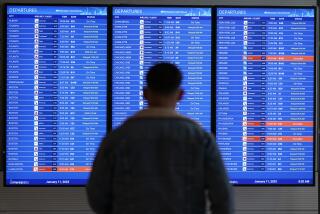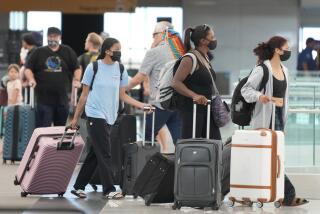Let’s Reregulate the Deregulated Airlines
- Share via
After deregulation in 1978, the number of airlines (except for commuter airlines) increased from 36 to 123, but 36 bankruptcies and 29 mergers or acquisitions have left 93 in operation. Some believe that these changes are the hallmark of a healthy industry in which “inefficient” firms are being driven out. But what it really indicates is an industry rife with excessive competition and forms of cost-cutting that threaten passenger safety.
The ardent deregulators claim that the turmoil and “shake-out” are desirable because they have made flying safer and cheaper than ever. All we need to worry about, they say, is too many mergers and too few airlines. Others note that bankruptcies and financial malaise often involve firms known for good management--such as Braniff, Continental and People Express.
When the deregulators point to fare-cutting wars and low accident rates as indicators that all is well, they ignore important evidence. When airlines are losing money and cannot raise fares because of excessive competition, they must keep cutting costs, and perhaps by too much. When a major airline announces that it carries as many passengers as before but with 22% fewer employees, that is flirting with danger. Deregulation led major airlines to abandon smaller cities to commuter lines that do not have to meet the same standards and whose safety records are much worse.
With relatively few major accidents, one must look at the causes of specific air disasters rather than at the number of deaths per million miles. Questionable profit-oriented practices have contributed to some accidents, the best example being the 1982 Air Florida crash during a snowstorm in Washington, D.C. The intrastate airline recently had expanded (as a result of deregulation) into northern routes, and the pilots on that flight had very limited experience with severe winter weather.
Yet deregulation advocates ignore such accidents, just as they ignore other trends of concern to safety-enforcement agencies whose job it is to spot dangerous problems before disaster occurs.
The Federal Aviation Administration fined airlines less than $100,000 for safety violations in 1982, tripled the amount in 1984, levied more than $2 million in 1985, and this year imposed fines of more than $10 million on Eastern and Pan American alone. The National Transportation Safety Board and members of Congress increasingly worry aloud about these trends and about the great increase in “close calls” (395 in 1981 and 777 in 1985) that reflects the dangerous air and ground congestion at major airports.
While the FAA’s overworked, understaffed control system is partly to blame, much of the congestion is due to the competitive pressures that force airlines to use too many connecting flights and too few nonstop flights between major cities. Hordes of planes arrive and leave at the same peak times (inefficient and risky), and millions of passengers crowd terminals such as Newark International Airport in order to change planes between Pittsburgh and Boston--a distance of only 483 air miles. Such trips should be nonstop. On such flights passengers are encouraged to carry heavy baggage on board because understaffed airlines cannot transfer it to connecting flights in time--a practice that could be deadly during severe turbulence or an accident.
The FAA, already a scapegoat for legislators who do not want to admit the error of deregulation, may seek to manage the wasteful and unnecessary congestion by installing a new air-traffic-control system without sufficient testing. This could result in the FAA’s being further pilloried for problems caused by deregulation.
The only cure is reregulation, but how? A government-sponsored conference of all domestic airlines should design a route system that removes the inefficient and risky congestion of deregulation. This would require an antitrust exemption similar to the permission given high-tech firms for joint research and development.
The conference also should propose streamlining the industry to reduce the number of airlines and flights, eliminating the cause of dangerous fare wars. After reorganization, a new Civil Aeronautics Board could supervise the system and keep fares high enough to maintain safety standards. Only the restoration of stability will enable long-term planning for fleet modernization, airport terminals and the traffic-control system to move forward.
More to Read
Inside the business of entertainment
The Wide Shot brings you news, analysis and insights on everything from streaming wars to production — and what it all means for the future.
You may occasionally receive promotional content from the Los Angeles Times.










